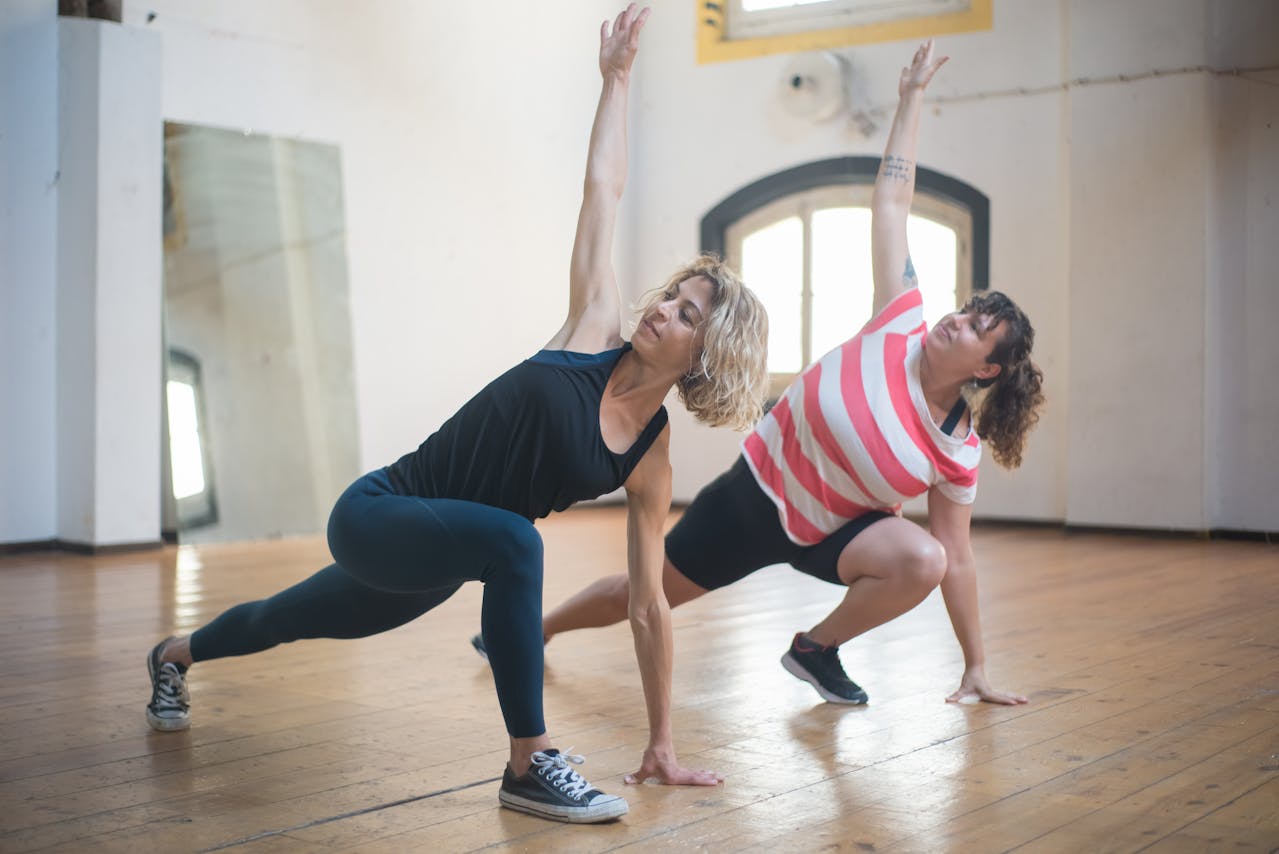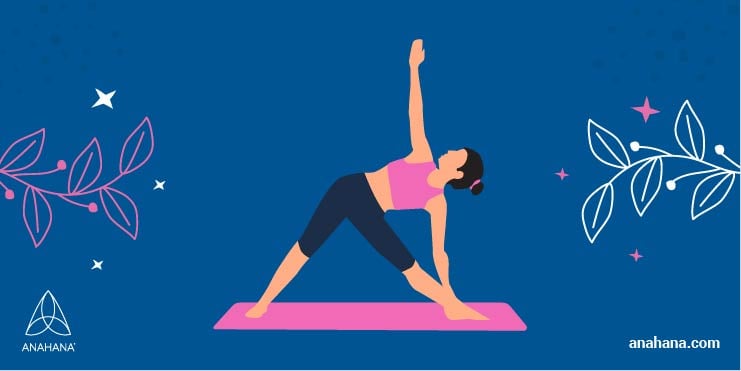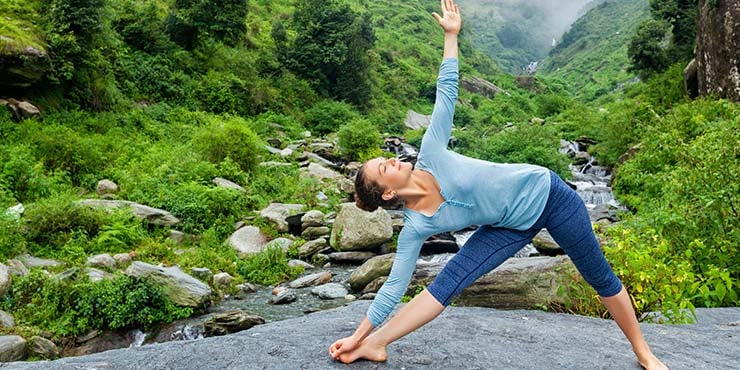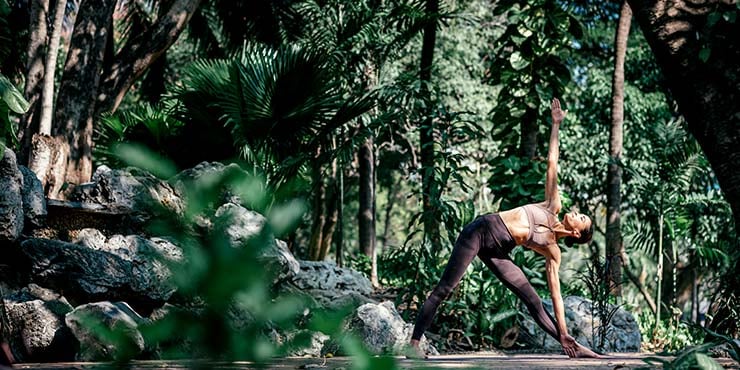
Table of Contents
Utthita Trikonasana, or Extended Triangle Pose, is a foundational standing yoga pose. It is often included in yoga sequences as it helps to increase flexibility in the hips, hamstrings, and spine, while also strengthening the legs and core.
Utthita Trikonasana
 Trikonasana, also known as Utthita Trikonasana, is an asymmetrical standing pose in yoga. In this pose, both of the practitioner's knees are straight, while their feet are approximately one leg's length apart on the ground, with both feet firmly placed on the floor. When practicing triangle pose, utthita trikonasana, we bend the body sideways, improving overall spine flexibility.
Trikonasana, also known as Utthita Trikonasana, is an asymmetrical standing pose in yoga. In this pose, both of the practitioner's knees are straight, while their feet are approximately one leg's length apart on the ground, with both feet firmly placed on the floor. When practicing triangle pose, utthita trikonasana, we bend the body sideways, improving overall spine flexibility.
Sanskrit Meaning
In Sanskrit, Trikonasana means Triangle pose or Three Angle pose. Utthita means extended, so it is also called the Extended Triangle pose.
Trikonasana Benefits
Trikonasana offers a range of benefits for the whole body. Some of the many benefits include:
- Strengthens the legs and abdominal muscles: Trikonasana enhances the front and back legs while engaging the core muscles to support the upper body.
- Improves balance and stability: This yoga pose challenges the practitioner's balance and stability, making it an excellent exercise for improving overall balance and coordination.
- Stretches and strengthens the back muscles: The spine is lengthened and stretched in Trikonasana, which can help alleviate tension and stiffness in the back muscles.
- Stimulates the abdominal organs and aids digestion: The twisting motion of the upper body in Trikonasana can help to stimulate the digestive organs, aiding digestion and elimination.
- Calms the nervous system: Trikonasana is a grounding and calming posture, making it an excellent exercise for relieving stress and anxiety.
- Increases energy levels and stamina: This posture requires significant physical effort, making it an excellent exercise for increasing energy levels and stamina.
- Promotes good posture and alignment: Trikonasana can help improve overall posture and alignment by stretching and strengthening the muscles that support the spine and maintaining proper body alignment.
- Stimulates the Manipura or Solar Plexus Chakra: As mentioned earlier, this posture associates with the Manipura or Solar Plexus Chakra, which supports self-esteem and confidence.
Trikonasana Contraindictions
Here are some contraindications to keep in mind when practicing Trikonasana:
- Low blood pressure: Those with low blood pressure should be cautious when practicing Trikonasana, as the posture can cause a sudden drop in blood pressure, leading to dizziness or lightheadedness.
- Neck or spine injuries: Those with neck pain, neck issues, or spine injuries should avoid practicing Trikonasana or modify the pose to prevent putting pressure on the neck or spine.
- Pregnancy: Pregnant women should avoid practicing Trikonasana or modify their posture to avoid putting pressure on the abdomen. It's best to consult a doctor or a qualified yoga teacher before practicing any yoga postures during pregnancy.
- High blood pressure: Those with high blood pressure should be cautious when practicing Trikonasana, as the yoga pose can cause a sudden increase in blood pressure. It's best to avoid the posture or modify it with the help of a qualified yoga teacher.
Preparatory Poses and Actions for Trikonasana
Preparation for Trikonasana may vary depending on which version of the pose is used. Users may find separate preparation redundant as they become more familiar with the posture.
Using a yoga block
It may be beneficial to use a yoga block to facilitate the preparation yoga poses for Trikonasana or the pose itself. When requiring support for the upper body through your arm, one should place the block beneath that arm's shoulder to increase reach.
Half moon
To warm up the legs, stimulate the foot and ankle muscles, and work on the hip and knee of that leg, Ardha Chandrasana, or Half Moon pose, may be practiced first. Before attempting this pose, try shifting weight to one foot with the foot turned out and maintain an upright torso. Doing so can enable one to concentrate more on supporting elements such as the foot, ankle, knee, or hip.
Pyramid pose
Following the Half Moon pose, Parsvottanasana, or Pyramid pose, is a common practice. It provides a chance to warm the muscles of the front foot while also preparing it for the extended ankle foot position. One can also work on activating the hip muscles of either the front or back leg or both.
After stimulating the muscles of one or both hips, focus on engaging the spinal erectors to support the upper body and free the hands from the front shin/floor. It will set them up to lift their hand in Triangle Pose, should they choose to do so.
Laterally rotated hip flexion explained
 In the Triangle pose, lateral rotation of the hip flexion occurs by stepping the feet apart, turning the foot ninety degrees, and turning out the thigh relative to the pelvis. Tilt the pelvis to the side, and an externally rotated hip is bent forward.
In the Triangle pose, lateral rotation of the hip flexion occurs by stepping the feet apart, turning the foot ninety degrees, and turning out the thigh relative to the pelvis. Tilt the pelvis to the side, and an externally rotated hip is bent forward.
Warrior 2 poses typically require approximately ninety degrees of hip flexion, while Utthita Parsvokonasana, Extended Side Angle pose, can involve more hip flexion if desired by tilting the pelvis to the side.
Trikonasana Step-by-step instructions
No matter which variation of Trikonasana you are practicing, the basic shape of the pose is reasonably constant. Here are the step-by-step instructions to performing the Triangle pose:
- Begin in Tadasana, or Mountain pose, standing straight with the feet hip-width apart and the arms at the sides.
- Step or jump the feet one leg's length apart, turning the right foot out 90 degrees and the left foot slightly inwards.
- Inhale and lift the arms parallel to the floor, keeping them aligned at shoulder height, palms facing down.
- Exhale and extend your torso forward—bending from your hip joint, not the waist—to reach your side body directly over your front leg.
- Place the right hand on the right shin, ankle, or floor outside the right foot. If more flexible, place the hand on a block.
- Reach the left arm straight up, keeping the arms aligned with the shoulders.
- Hold the pose for a few breaths, lengthening the spine on inhales and deepening the stretch on exhales.
- To release the pose, inhale and lift the torso back up to a standing position, straighten the right leg, and return to Tadasana.
- Repeat on the other side, turning the left foot 90 degrees and repeating the above steps.
Body Alignment in Triangle Pose
Heel Alignment
The practitioner can position their feet in one of two ways. The first option is to place their heels on the same line. The second option is to adjust their foot position so that the heel of their front foot aligns with the arch of their back foot.
Tilting the hips
When facing the mat's long edge, the practitioner should drop their right hip, causing their torso to tilt to the right. This movement will result in the left hip raising and the hips shifting to the left. The practitioner should keep their torso over their right leg as much as possible throughout the pose. Allow the back hip to roll forward to avoid straining the lower back and damaging the SI joint.
Bottom hand
The practitioner should rest their right hand on their shin or a yoga block in front of or beyond their shin. They can also place their hand on the floor if their flexibility allows. As an option, mainly if practicing Trikonasana as part of an Ashtanga yoga sequence, the practitioner can grab onto the big toe of their front foot with their left fingertips and thumb of their right hand.
Gaze
Practitioners can gaze upward and straight ahead to help open the chest and send energy to the heart chakra. If this is uncomfortable for your neck, keeping the head in a more neutral position is also acceptable.
The Arms
The usual position in the Triangle pose is for the practitioner's top arm, the left arm in this case, to reach straight up. To achieve this, bring the raised arm over the ear parallel to the floor.
The other arm, in this case, the right arm, has a few options: it can rest on the floor on the inside or outside of the leg, or it can grasp the big toe with the middle and index fingers. Whichever variation you choose, engage your upper arms for greater balance. The arms should be in a straight line with the shoulders stacked.
Working From the Ground Up
Activating Feet and Ankles
The practitioner can work on activating or stiffening the front and back foot and ankle muscles. As they work on activating these muscles, they can adjust the amount of rotation to ensure that the activation feels comfortable.
Adjusting Shin Rotation
For those unfamiliar with shin rotation, it can be performed while standing upright with feet hip-width apart and knees slightly bent. To externally rotate the shins, the foot's inner arch will lift higher, while internally rotating will lower and even flatten the arch. In Trikonasana, practitioners can first adjust the front foot's shin rotation, maintaining floor contact with the inside of the forefoot. Then, they can play with the shin rotation of the back foot and notice its effect on the back, leg, and hip. Practitioners may choose to vary the shin rotation for each foot as they go deeper into the pose, adjusting as needed to maintain comfort.
Activating the Knees
In Trikonasana, practitioners can activate the back, side, and front knee muscles even when the knees are straight to create stability. To do this, they can exert the knee muscles against each other. Do not lock the front knee (keeping a micro bend will help).
If practicing the right side Trikonasana, the practitioner can first focus on making the right knee strong and then activate the knee of the left leg. This can help create a stable foundation for the pose.
Activating the Thighs
Practitioners should aim to activate the thigh muscles during Trikonasana. The opposing muscles will automatically activate when activating one set of muscles, whether the outer or inner thighs. For example, activating the front of the thigh will cause the back of the thigh to activate in opposition.
Practitioners can also focus on feeling the inside or outside of the knee or both when activating the inner or outer thighs. If aiming to activate the hamstrings, activate the foot first. Activating the entire front, back, inside, or outside of the thigh will affect the knee joint and hip flexors.
Adjusting The Pelvis and Lower Back
When standing in mountain pose, tilting the pelvis forward while keeping the torso upright will increase the back bend in the lumbar spine, while tilting the pelvis backward will flatten the curve in the lumbar spine (or create a slight forward bend for those who are very flexible).
In the Triangle pose, while keeping the torso tilted over the front leg, the practitioner can experiment with tilting the pelvis forward to increase the back bend in the lumbar spine or tilting it backward to flatten the curve in the lumbar spine. Practitioners should first practice these movements with the torso upright before bending to the side for the Triangle pose.
The practitioner should find a comfortable degree of gentle pelvic tilt on the hip joints and lower back. Depending on whether an arm is used to support the body weight or not, the direction and degree of pelvic tilt may need to be adjusted.
Adjusting Spinal Side Bend
 While performing the Triangle pose, one can keep their spine straight from side to side or bend it to the side. If doing the right side Trikonasana, they can maintain a straight spine instead of bending it to the right. Alternatively, they can choose to bend the spine to the side. In both cases, it is essential to work on elongating the spine.
While performing the Triangle pose, one can keep their spine straight from side to side or bend it to the side. If doing the right side Trikonasana, they can maintain a straight spine instead of bending it to the right. Alternatively, they can choose to bend the spine to the side. In both cases, it is essential to work on elongating the spine.
Activating The Waist
In the Triangle pose, activating the feet or thighs can help perform the pose without arm support. Gradually relaxing and lifting the bottom arm can activate the muscles along the side body for extra support. Keep the waist long to activate the muscles, or focus on increasing activation on the top side of the waist while keeping the spine straight or allowing it to bend downwards.
Lifting the bottom hand in Trikonasana will activate the hip muscles, and you can focus on activating the muscles of the extended leg hip, the back leg hip, or both. Focusing on the back leg hip can provide better support for the upper side of the waist. If you have difficulty activating the muscles of the back leg, you can try varying the rotation of your shin or foot to see if it helps.
References
Get to Know the 8 Limbs of Yoga
What Is Yoga Nidra? – Cleveland Clinic.
How to do Vinyasa Flow | ClassPass.
Ashtanga Yoga IS Hard—A Beginner's Guide to How to Practice – OmStars.
Iyengar 201: The Strap Trick You Need to Try to Release Your Neck Tension
Intro to Chanting, Mantra, and Japa
What is Om Namah Shivaya? - Definition from Yogapedia
What is Shabda Brahman? - Definition from Yogapedia
Disclaimer
The contents of this article are provided for informational purposes only and are not intended to substitute for professional medical advice, diagnosis, or treatment. It is always recommended to consult with a qualified healthcare provider before making any health-related changes or if you have any questions or concerns about your health. Anahana is not liable for any errors, omissions, or consequences that may occur from using the information provided.

By: Anahana
The Anahana team of researchers, writers, topic experts, and computer scientists come together worldwide to create educational and practical wellbeing articles, courses, and technology. Experienced professionals in mental and physical health, meditation, yoga, pilates, and many other fields collaborate to make complex topics easy to understand.
